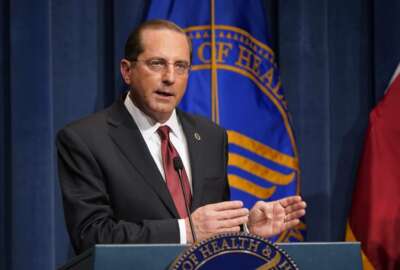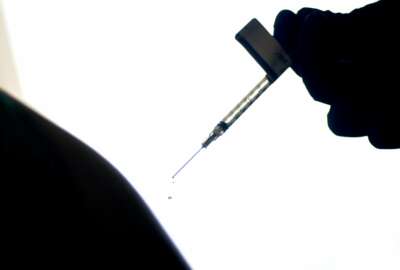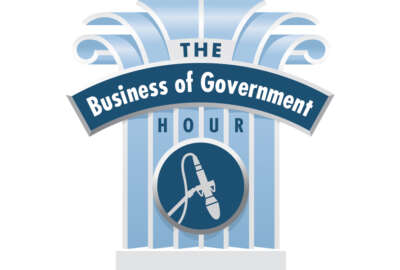How Operation Warp Speed led to a vaccine
As the federal health apparatus contemplates whether a second COVID-19 booster shot is a good idea, it's good to recall the national effort that resulted in...
Best listening experience is on Chrome, Firefox or Safari. Subscribe to Federal Drive’s daily audio interviews on Apple Podcasts or PodcastOne.
As the federal health apparatus contemplates whether a second COVID-19 booster shot is a good idea, it’s good to recall the national effort that resulted in vaccines in the first place. The Federal Drive with Tom Temin got a look back from the former Health and Human Services deputy chief of staff who oversaw Operation Warp Speed, Paul Mango.
Interview transcript:
Tom Temin: Mr. Mango, good to have you on.
Paul Mango: Hey, Tom, thanks for having me.
Tom Temin: And people forget about how these vaccines kind of did come into existence. It was really a collaboration, I guess, you might say, between the private sector and the government from the inside. Tell us more about what it looked like and how this whole thing got started?
Paul Mango: Yeah, well, I’ll tell you how it got started. It was in March of 2020. And we had already been engaging some of the pharmaceutical industry. At the end of March, the 28th, I think or 29th, we issued a grant to Johnson & Johnson for $450 million to help develop its vaccine. And Secretary Azar asked a very important question, what are we getting for that 450 million? And the answer we got was, well, they’ll start their trials in September and Azar who had come from the pharmaceutical industry said, that’s business as usual. We can’t do that. And that was the impetus literally for a strategy, which was designed to tremendously accelerate without compromising safety and effectiveness, the development, manufacturing and distribution and administration of vaccines known as Operation Warp Speed. So that’s how it started.
Tom Temin: And how did it morph into so many pharmaceutical companies three or four coming up with vaccines more or less simultaneously?
Paul Mango: Yeah, well, we had a great chief scientific adviser, Moncef Slaoui, who was the most successful vaccine developer of our generation, he had put 14 successful vaccines in the market. And when he came in as an advisor, he developed what we would call a venture capitalist mindset, meaning let’s play some bets. We only have to win one. So what he did was he chose three different technology platforms. mRNA, whichever you want is familiar with, that’s Pfizer and Moderna, and then what’s called viral vector, which was Johnson & Johnson and AstraZeneca. And then there’s a third one called protein subunit, which is Nova Vax and GSK, Sanofi. But Moncef also knew and Gus Perner, the general in charge of logistics knew that we couldn’t go much beyond just a handful of candidates because the logistics of getting the needles, getting the syringes, all of which took different sizes, by the way, you know, different intervals between one dose and another, that logistics would be tremendously complicated if we went beyond about six candidates. So we we settled on six, and three of them were winners. So that’s not bad for a venture capital strategy.
Tom Temin: Right. And what kind of oversight or check-ins or dashboards did the administration have into this process as it proceeded?
Paul Mango: I talked about this in the book. It’s very interesting. And this was actually one of my roles was to keep the White House intently informed of what was going on with Operation Warp Speed. So I’d have meetings over there twice a day, Jared Kushner would convene a meeting at eight in the morning. And then we’d have the White House Coronavirus Taskforce meeting led by Vice President Pence in the afternoon. And my role was to bring them updates on what was happening, how many doses were manufactured, when we thought things were going to be submitted to the FDA. And what that served, Tom, a very important purpose, which was it kept the team protected from distractions. So I kind of protected the team, they kept their heads down and did what they needed to do. I kept the White House and everyone else up to date.
Tom Temin: Was there any cross talk among the companies that were competing for this? Because maybe, if it’s a warp speed situation, and someone came up with something at Pfizer that someone at Mo derna could use? Why not share it?
Paul Mango: Yeah, so there was a lot of collaboration. And we used a mechanism called Defense Production Act, Title VII, and what that is, Tom, that permits in times of emergency competitors to collaborate. And they couldn’t exchange any information on pricing or whatever, but they could exchange information on technologies and development. And indeed, what we wound up doing was engaging some pharmaceutical firms to manufacture vaccines of other companies’ actual vaccines. So it was a highly collaborative effort. And I think the industry really stepped up and did a nice job.
Tom Temin: Almost like Ford Motor Company making B24s in World War II.
Paul Mango: Precisely and Ford Motor Company, by the way, manufacturing ventilators in 2020, they kind of converted over their lines to do that so that we’d have enough ventilators, for the American people.
Tom Temin: We’re speaking with Paul Mango. He’s former Health and Human Services deputy chief of staff, he oversaw Operation Warp Speed and has a book out by the same title. And at what point did you realize that you were going to get to that finish line?
Paul Mango: Well, it’s very interesting, Tom, when we interviewed Moncef Slaoui in April of 2020, and we interviewed many candidates for that role, by the way, former government officials from the NIH and so forth from the FDA. The point is he came in, he had been a board member at Moderna. And believe it or not, Moderna already had a good vaccine by April of 2020. We didn’t know that but they had a good vaccine. What do I mean? Well, we hadn’t taking us through the trials. It hadn’t been manufactured at scale. So we were confident that the scientific aspect of this would be done in time, what we were less confident about was the manufacturing, because manufacturing vaccines in five liter increments versus 2,000 is a very different science. So anyway, we knew to answer your question specifically, we knew the clinical trials were going very well in August and September of 2020. So we had a very good hunch that we would be done before the end of the year and have at least one safe and effective vaccine manufactured at scale.
Tom Temin: And was there prior science here because my understanding of this is limited, but there are 15 or 16, families of viry that could wipe out mankind and the COVID-19 was in the family where we have some experience in developing vaccines already. And unlike say, the polio vaccine took 50 years between discovery and a vaccine. Is that the case?
Paul Mango: I don’t know all of the science behind it, Tom. But I think the chief difference this time round was that the mRNA technology which had been under development for over a decade, Moderna was collaborating with the NIH before the pandemic on cancer treatments, and they pivoted very quickly. And this technology is very dexterous, if you will, you can use it for different things. And that I think, is what made the biggest difference more than the coronavirus being in a family that was quote familiar to us.
Tom Temin: And on the mechanical side of this, I imagine there’s more to building packaging and distributing the vaccines than simply making a big vat and pouring it into little tiny bottles. You see the video B roll on television of these millions of bottles flying past. Did the industry have to gear up for the volume in this case?
Paul Mango: Absolutely. And one of the most demanding items, Tom was the fact that the Pfizer vaccine had to be stored and transported at -80 degrees Celsius. And we didn’t have glass that could handle the vaccine at that temperature without shattering. Corning had to develop that special vial in a very, very short period of time. We had to secure a billion needles and syringes from various places around the world. And you can imagine everyone was trying to get their hands on those things. We had to create an information technology system that could track the delivery of these vaccines from factory through to warehouse to shipping hubs, FedEx and UPS and then out to 50,000 different locations because we had to keep track of where they all were. So it was a very sophisticated logistical operation led by the Army Materiel Command. If there’s any folks from the Army listening, they should be very proud of their colleagues who did just a fantastic job, but mainly a logistics challenge more than a scientific challenge.
Tom Temin: And by the way, where are injection needles mostly made?
Paul Mango: Well, a lot of them were made in China, and we had to secure some from there. But there’s other American firms like Becton Dickinson. I think that’s a common name for people in the medical industry. And we had to help them ramp up their manufacturing capacity. So part of this was where they were originally sourced from. But another part of it was we had to expand or start from scratch 27 different factories to manufacture everything that goes into these vaccines, including needles and syringes.
Tom Temin: So was all of this learning and experience somehow rolled up into a document that could have been left for future operatives in the federal government?
Paul Mango: Well, Tom, that’s actually what I’m hoping the book serves that purpose. It’s not a political book at all. It’s a book about a great American achievement. And more important, there’s a whole series of chapters in there about lessons learned. And even, there’s a chapter called if we could turn back time, meaning things we would have done differently if we could have started from scratch. So I think this will be at least as far as I’m concerned, a definitive record of what happened, what we did, right what we did wrong, it wasn’t perfect. It was very, very good. But it wasn’t perfect. And hopefully it will be a real anthology, if you will, for future public health crises.
Tom Temin: And by the way, what is the top thing you might have done differently? Do you think?
Paul Mango: Well, I think it’s communicating with the American people. We early on made a decision not to create too much enthusiasm for these vaccines because we weren’t sure we were going to have one. Could you imagine if all 2020, we got the American people all lathered up about the vaccine is coming. The vaccine is coming. And then the FDA says sorry, this isn’t a safe and effective vaccine. So we kept a low key on that communication. I think we could have done that differently.
Tom Temin: Paul Mango is former deputy chief of staff at Health and Human Services. Thanks so much for joining me.
Paul Mango: Thanks, Tom.
Copyright © 2025 Federal News Network. All rights reserved. This website is not intended for users located within the European Economic Area.
Tom Temin is host of the Federal Drive and has been providing insight on federal technology and management issues for more than 30 years.
Follow @tteminWFED






